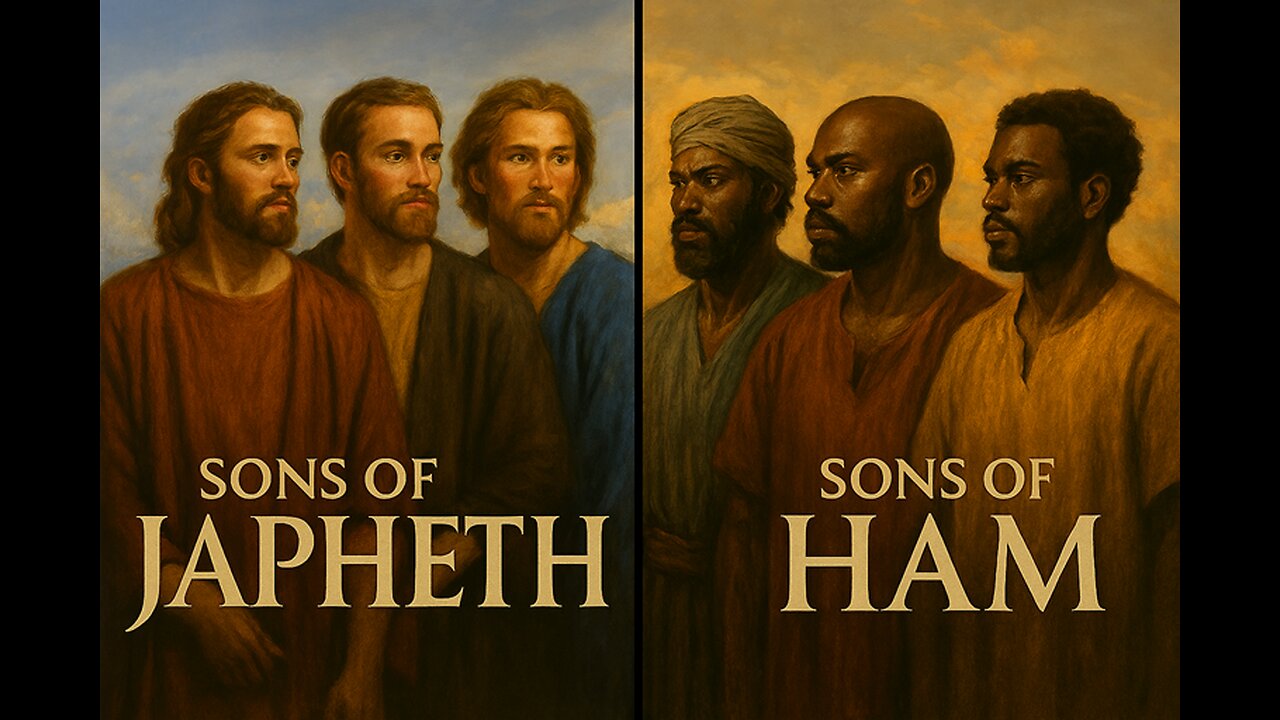Premium Only Content

Lesson 69: The Sons of Noah - Japheth pt2, Ham pt1
The Bible Show
Lesson 69: The Sons of Noah - Japheth pt2, Ham pt1
10/01/2020
EvolutionPOP.com
First, finishing up the sons of Japheth's son Javan -- Elishah, Tarshish, Kittim, and Dodanim.
01.) Genesis 10:1-5 (Noah, Japheth, Gomer, and Javan).
02.) Genesis 10:4 (Sons of Javan - Elishah, Tarshish, Kittim, and Dodanim).
03.) Elishah
McClintock and Strong Biblical Cyclopedia
BiblicalCyclopedia.com
https://www.biblicalcyclopedia.com/E/elishah.html
He seems to have given name to a region on the Mediterranean, "the isles (אִיּיס, shores) of Elishah," which are described as exporting fabrics of purple and scarlet to the markets of Tyre (Eze 27:7). If the descendants of Javan peopled Greece, we may expect to find Elishah in some province of that country.
04.) Ezekiel 27:1-7 (Isles of Elishah).
05.) Tarshish
BibleStudyTools.com
https://www.biblestudytools.com/dictionary/tarshish/
The name of a place which first comes into notice in the days of Solomon. The question as to the locality of Tarshish has given rise to not a little discussion. Some think there was a Tarshish in the East, on the Indian coast, seeing that "ships of Tarshish" sailed from Eziongeber, on the Red Sea (1 Kings 9:26 ; 22:48 ; 2 Chr 9:21). Some, again, argue that Carthage was the place so named.
There can be little doubt, however, that this is the name of a Phoenician port in Spain, between the two mouths of the Guadalquivir (the name given to the river by the Arabs, and meaning "the great wady" or water-course).
It was founded by a Carthaginian colony, and was the farthest western harbour of Tyrian sailors. It was to this port Jonah's ship was about to sail from Joppa. It has well been styled "the Peru of Tyrian adventure;" it abounded in gold and silver mines.
It appears that this name also is used without reference to any locality. "Ships of Tarshish" is an expression sometimes denoting simply ships intended for a long voyage (Isaiah 23:1 Isaiah 23:14), ships of a large size (sea-going ships), whatever might be the port to which they sailed. Solomon's ships were so styled (1 Kings 10:22 ; 22:49).
05a.) 1 Kings 9:26
05b.) 1 Kings 22:48-49
05c.) 2 Chr 9:21
05d.) 1 Kings 10:22
05e.) 1 Kings 22:49
06.) Kittim
BibleStudyTools.com
https://www.biblestudytools.com/dictionary/kittim/
In Genesis 10:4 the word is applied to the descendants of Javan, and indicates, therefore, the Greek-Latin races, whose territory extended along the coasts of the Mediterranean, and included its islands. By the side of Kittim are mentioned Elisha, Tarshish, and Dodanim ( = Rodanim of 1 Chronicles 1:7), generally explained respectively as Sicily with Southern Italy, Spain and Rhodes. In its narrower sense Kittim appears simply to have stood for the island of Cyprus--it is mentioned between Bashan ( = Pal) and the isles of Elisha in Ezekiel 27:6,7, and with this Isaiah 23:1,12 agree, Kittim occurring in these passages between Tarshish, Tyre and Sidon.
07.) Dodanim
Classic.net.Bible.org
http://classic.net.bible.org/dictionary.php?word=Dodanim
a race descended from Javan (Gen. 10:4). They are known in profane history as the Dardani, originally inhabiting Illyricum. They were a semi-Pelasgic race, and in the ethnographical table (Gen. 10) they are grouped with the Chittim (q.v.). In 1 Chr. 1:7, they are called Rodanim. The LXX. and the Samaritan Version also read Rhodii, whence some have concluded that the Rhodians, the inhabitants of the island of Rhodes, are meant.
07a.) Dardni
AlbanianStudies.Weebly.com
https://albanianstudies.weebly.com/dardania.html
The etymology of the name Dardania has been associated with the Albanian word "dardha" meaning pear. [1] Bardyllis was a king of Dardania whose name in Albanian literally means "White-Star" from Bardh(White) and Yll(Star).[2] The region was inhabited by Illyrians, Celts[3][4] and Thracians.[4][5] After Roman conquest of Illyria at 168 BC, Romans colonized and founded several cities in the region.[6]
The borders of Dardania have seen many administration divisions through out the ages while almost always occopying the same region. The region saw some continuity during the Ottoman period of the region under the Villayete of Kosovo while today it occupies the country of Kosovo, the ethnic Albanian regions of Serbia such as the Preshevo Valley in Serbia, Sanjac and the ethnic populated Albanian regions of the Republic of Macedonia.
07b.) Illyricum
Britannica.com
https://www.britannica.com/place/Illyria#ref87154
Illyria, northwestern part of the Balkan Peninsula, inhabited from about the 10th century bce onward by the Illyrians, an Indo-European people. At the height of their power, the Illyrian frontiers extended from the Danube River southward to the Adriatic Sea and from there eastward to the Šar Mountains.
The Roman province of Illyricum stretched from the Drilon River (the Drin, in modern Albania) in the south to Istria (modern Slovenia and Croatia) in the north and to the Savus (Sava) River in the east; its administrative centre was Salonae (near present-day Split) in Dalmatia.
The walls of Daorson
07c.) Semi-Pelasgic Race
TheFreeDictionary.com
https://www.thefreedictionary.com/Pelasgic
Pe•las•gi•an (pəˈlæz dʒi ən, -dʒən, -gi ən)
A member of a people living in the region of the Aegean Sea before the coming of the Greeks.;
A member of a people inhabiting parts of the S Balkan Peninsula, Aegean islands, and the coast of Asia Minor prior to the Hellenic invasions of the 2nd millennium b.c.
07d.) Chittim
BibleStudyTools.com
Eastons-Bible-Dictionary
https://www.biblestudytools.com/dictionaries/eastons-bible-dictionary/chittim.html
Chittim
Chittim (or Kittim, a plural form) ( Genesis 10:4 ), the name of a branch of the descendants of Javan, the "son" of Japheth.
The references elsewhere made to Chittim ( Isaiah 23:1 Isaiah 23:12 ; Jeremiah 2:10 ; Ezekiel 27:6 ) are to be explained on the ground that while the name originally designated the Phoenicians only, it came latterly to be used of all the islands and various settlements on the sea-coasts which they had occupied, and then of the people who succeeded them when the Phoenician power decayed. Hence it designates generally the islands and coasts of the Mediterranean and the races that inhabit them.
07e.) Island of Rhodes
DuckDuckGo.com (images)
https://duckduckgo.com/?t=ffnt&q=island+of+rhodes&ia=web&iaxm=about&iax=images
Rhodes is the largest of the Dodecanese islands of Greece and is also the island group's historical capital. Historically, Rhodes island was very famous worldwide for the Colossus of Rhodes, one of the Seven Wonders of the Ancient World. The Medieval Old Town of the City of Rhodes has been declared a World Heritage Site. Today, it is one of the most popular tourist destinations in Europe.
07e2.) Island of Rhodes
RhodesTouristGuide.com
http://www.rhodestouristguide.com/2012/01/location-of-the-island-of-rhodes/
Location of the Island of Rhodes
Rhodes belongs to the Dodecanese island group, comprising 12 larger and 150 smaller islands. It is located some 200 nautical miles south east of the Greek mainland and lies in the shadow of Asia Minor which is only 11 nautical miles distant. It is bordered to the north by the North Aegean islands of Samos and Ikaria, the Cyclades to the west, Crete to the south west and Turkey to the east. To the west of the island is the Carpathian Sea whilst to the north and north west is the Sea of Rhodes.
================================================
Ham
08.) Genesis 10:6-20 (The sons of Ham).
09.) Genesis 10:6 (Cush, Mizraim, Phut, and Canaan).
10.) Cush
CollinsDictionary.com
https://www.collinsdictionary.com/dictionary/english/cush
Kush; The son of Ham and brother of Canaan (Genesis 10:6); The country of the supposed descendants of Cush (ancient Ethiopia), comprising approximately Nubia and modern Sudan, and the territory of southern (or Upper) Egypt.
11.) ChristianAnswers.net
https://christiananswers.net/dictionary/cush.html
Cush
Meaning: black
This is the name of 2 biblical men and an ancient land associated with the earlier man.
Cush, a son of Ham, probably the eldest, and the father of Nimrod (Genesis 10:8; 1 Chronicles 1:10)
From him the land of Cush seems to have derived its name.
Land of Cush—The term Cush is in the Old Testament generally applied to the countries south of the Israelites. It was the southern limit of Egypt (Ezek. 29:10, King James Version “Ethiopia,” Hebrew: Cush), with which it is generally associated (Psalm 68:31; Isaiah 18:1; Jeremiah 46:9, etc.).
It stands also associated with Elam (Isaiah 11:11), with Persia (Ezek. 38:5), and with the Sabeans (Isaiah 45:14).
From these facts it has been inferred that Cush included Arabia and the country on the west coast of the Red Sea. Rawlinson takes it to be the country still known as Khuzi-stan, on the east side of the Lower Tigris. But there are intimations which warrant the conclusion that there was also a Cush in Africa, the Ethiopia (so called by the Greeks) of Africa.
The ancient historian Herodotus wrote,
For of the four sons of Ham, time has not at all hurt the name of Cush; for the Ethiopians, over whom he reigned, are even at this day, both by themselves and by all men in Asia, called Cushites. —Herotodus, Antiquities of the Jews 1.6)
Ezekiel speaks (29:10; compare 30:4-6) of Cush as lying south of Egypt. It was the country now later known as Nubia (today central Sudan and southern Egypt) and Abyssinia (Ethiopia) (Isaiah 18:1; Zeph. 3:10, Hebrew: Cush). In ancient Egyptian inscriptions, Ethiopia is termed Kesh.
The Cushites appear to have spread along extensive tracts, stretching from the Upper Nile to the Euphrates and Tigris. At an early period there was a stream of migration of Cushites “from Ethiopia, properly so called, through Arabia, Babylonia, and Persia, to Western India.”
The Hamite races, soon after their arrival in Africa, began to spread north, east, and west. Three branches of the Cushite or Ethiopian stock, moving from Western Asia, settled in the regions contiguous to the Persian Gulf.
One branch, called the Cossaeans, settled in the mountainous district on the east of the Tigris, known afterwards as Susiana; another occupied the lower regions of the Euphrates and the Tigris; while a third colonized the southern shores and islands of the gulf, whence they afterwards emigrated to the Mediterranean and settled on the coast of Israel as the Phoenicians.
Nimrod was a great Cushite chief. He conquered the Accadians, a Tauranian race, already settled in Mesopotamia, and founded his kingdom, the Cushites mingling with the Accads, and so forming the Chaldean nation.
12.) Genesis 10:8-12 (Nimrod the mighty one).
13.) ChristianityBeliefs.org
http://christianitybeliefs.org/thefuelproject/the-birth-of-tammuz-and-polytheism/
The Birth of Tammuz And Polytheism
This Christianity beliefs video from The Fuel Project tells the story of Tammuz. Semiramus had became pregnant with an illegitimate son and Nimrod threatened to dethrone her and expose her past as a prostitute. She apparently then plotted to have Nimrod killed.
Afterwards, she presented her son Tammuz as an immaculately conceived reincarnation of Nimrod. She presented him as the seed of the woman presented in Genesis 3, the messiah, and so Tammuz was the first Christ impostor, the first antichrist.
After his death, Nimrod was revered as the god Marduk, also known as Baal – The Sun God, which is the primary name that other people would come to worship Marduk.
Semiramus was revered as the Moon Goddess, Great Mother, Divine Mother and Virgin Mother.
14.) References to Nimrod
TheFamousPeople.com
https://www.thefamouspeople.com/profiles/nimrod-38704.php
ChristianAnswers.net
https://christiananswers.net/dictionary/nimrod.html
15.) Mizraim
Abarim-Publication.com
https:/www.abarim-publications.com/Meaning/Mizraim.html#.X2tFHR5OnZF
The Name Mizraim in the Bible
Mizraim is a son of Ham, son of Noah (Genesis 12:10). This name is also the common name for Egypt (which is also known as 'the land of Ham,' for instance in Psalm 105:23).
16.) Psalms 105:6-7, 23-27 (Egypt, the land of Ham).
17.) BlackHistoryInTheBible.com
https://www.blackhistoryinthebible.com/africa-and-arabia/egypt/
2 Videos:
-Mostafa Hefny a black, Arab, Egyptian.
-Joel A. Freeman PhD - teaches Egyptian history (FreemanInstitute.com)
Egypt (Mizraim)
Perhaps most famous for it’s pyramids, Egypt is probably the second most important country mentioned in the Bible, with Israel being the first. With the exception of the pre-flood world, the majority of Genesis revolves around Egypt.
One of the alternative names the Bible uses for the geographic area is “the land of Ham”. This reference is made three times in scripture.
“Israel also came into Egypt; and Jacob sojourned in the land of Ham.” – Psalms 105:23
“They shewed his signs among them, and wonders in the land of Ham.” – Psalms 105:27
“Wondrous works in the land of Ham, and terrible things by the Red sea.” – Psalms 106:22
Egypt is located in Africa, and is recognized as a black civilization by the vast majority of people.
Hebrews Were Mistaken For Descendants of Ham
In the bible, "Hebrews get mistaken for Hamites from Genesis through Acts. We know what Egyptians looked like without an ounce of speculation because Egyptians painted themselves as black people."
Joseph – Unrecognizable As A Hebrew (Genesis 42:7-8)
The Nation of Israel – Indistinguishable From Egyptians (Genesis 50:8-11)
18.) Phut
BlacksInTheBible.net
http://www.blacksinthebible.net/phoeniciansdoc.htm
PHUT
Founder of Phoenicia Home of the Seafaring People
Phut was Ham’s third son who struck out on his own and founded the nation of Libya on the Mediterranean coast of the African continent where Zidonian-Canaanites migrated after leaving their servitude in Lebanon. (1 Kings 9:26) At that time the land of Phut was called Phoenicia and it was occupied by these black people before Abraham’s Arabian descendants invaded North Africa. These Canaanites were slaves in Lebanon where they were known as Zidonians, named after Canaan’s son Zidon. (Fig. 8) These Canaanites in particular performed remarkable craftsmanship with the famed cedars trees of Lebanon of which the Scriptures speak. These black men were so skillful in wood that their reputation attracted the attention of the wisest man in the world.
19.) BibleHub.com
https://biblehub.com/topical/p/phut.htm
How Every Nation was Denominated from their First Inhabitants.
... Phut also was the founder of Libya, and called the inhabitants Phutites, from himself:
there is also a river in the country of Moors which bears that name
20.) FamilyPedia.Wikia.org
https://familypedia.wikia.org/wiki/Phut
Phut or Put is the third son of Ham (one of the sons of Noah), in the biblical Table of Nations (Genesis 10:6; cf. 1 Chronicles 1:8). The name Put (or Phut) is also used in the Bible for the people or nation said to be descended from him, usually placed in Ancient Libya, but connections are sometimes proposed with the Land of Punt[1] known from Ancient Egyptian annals.
A Libyan connection has likewise been inferred from Nahum 3:9, where it is said that "Put and Lubim" were the helpers of Egypt. Other biblical verses consistently refer to the descendants of Put as warriors.
The Libyan tribe of pỉdw shows up in Egyptian records by the 22nd dynasty, while a Ptolemaic text from Edfu refers to the t3 n nꜣ pỉt.w "the land of the Pitu". The word was later written in Demotic as Pỉt, and as Phaiat in Coptic, a name for Libya Aegypti, northwestern Egypt.
21.) Canaan
Genesis 10:15 (sons of Canaan).
22.) Genesis 15:1, 18-21 (from river of Egypt to river Euphrates).
23.) JewishVirtualLibrary.org
https://www.jewishvirtuallibrary.org/land-of-canaan
No single geographical definition for the land of Canaan exists in the Bible (Num. 34:2–12; Ezek. 47:13–20; 48:1–7, 23–29) or in other sources. The term occasionally indicates an extensive area encompassing all of Palestine and Syria, while at other times it is confined to a strip of land along the eastern shore of the Mediterranean (for the southern boundary, see Joshua 15:2–4, and for the northern boundary, see Joshua 19:24–31). According to Genesis 10:19, Canaan extended in a restricted fashion from Sidon in the north to Gaza, Gerar, and the southern end of the Dead Sea in the south. The inclusion of Zemar, Arvad, and Sin (Siyanu, to the south of Ugarit) in Genesis 10:15–18, and the mention of Ammia (near Tripoli) as a city "in the Land of Canaan" in the inscriptions of Idrimi, king of *Alalakh (dated by various scholars to the 15th–13th centuries B.C.E.), indicate that even areas north of Sidon were included in the land of Canaan.
(Note: Canaan's first born son is named Sidon - Genesis 10:15).
24.) KidsPressMagazine.com
Tectonic Plates
25.) ThoughtCo.com
https://www.thoughtco.com/what-is-the-middle-east-2353342
What Is the Middle East?
A Controversial Term
The "Middle East" is not a term Middle Easterners gave themselves, but a British term borne of a colonial, European perspective. The term's origins are seeped in controversy for having originally been a European imposition of geographic perspective according to European spheres of influence. East from where? From London. Why "Middle"? Because it was half-way between the United Kingdom and India, the Far East.
By most accounts, the earliest reference to the "Middle East" occurs in a 1902 edition of the British journal National Review, in an article by Alfred Thayer Mahan entitled "The Persian Gulf and International Relations." The term gained common usage after it was popularized by Valentine Chirol, a turn-of-the-century correspondent for the London times in Tehran. Arabs themselves never referred to their region as the Middle East until the colonial usage of the term became current and stuck.
-
 1:41:04
1:41:04
The Quartering
3 hours agoEpstein Files Takes Its First Scalp, MTG Unleashes, Kash Patel Blasted, Internet Outage & More
104K70 -
 LIVE
LIVE
Dr Disrespect
6 hours ago🔴LIVE - DR DISRESPECT - ARC RAIDERS - NO MERCY TO MAX LEVEL
1,580 watching -
 24:53
24:53
Jasmin Laine
1 hour ago“NO ONE BELIEVES YOU”—Carney Gets HUMILIATED in BRUTAL Showdown
548 -
 LIVE
LIVE
LFA TV
19 hours agoLIVE & BREAKING NEWS! | TUESDAY 11/18/25
1,370 watching -
 LIVE
LIVE
freecastle
6 hours agoTAKE UP YOUR CROSS- The fear of the LORD begins knowledge; Fools despise WISDOM and INSTRUCTION.
49 watching -
 5:16
5:16
Buddy Brown
4 hours ago $1.19 earnedWatch INSANE Video of Woman Denied a TINY HOME on 37 Acres! | Buddy Brown
4.14K6 -
 59:19
59:19
Professor Nez
3 hours ago🔥 Trump TORCHES ABC Reporter for Disrespecting Saudi Crown Prince Mohammed bin Salman! (WOW!)
19.1K18 -
 7:51
7:51
Dr. Nick Zyrowski
7 hours agoHow To Starve Fat Cells - Not Yourself!
19.6K4 -
 LIVE
LIVE
The HotSeat With Todd Spears
2 hours agoEP 211: Less Religion, More JESUS!
486 watching -
![[Ep 794] Epstein Act | MTG 2.0 [Liz Cheney?] | Crooks, Furries, & Social Media | Guest – Sam Anthony](https://1a-1791.com/video/fww1/1b/s8/1/u/D/2/A/uD2Az.0kob-small-Ep-794-Epstein-Act-MTG-2.0-.jpg) LIVE
LIVE
The Nunn Report - w/ Dan Nunn
2 hours ago[Ep 794] Epstein Act | MTG 2.0 [Liz Cheney?] | Crooks, Furries, & Social Media | Guest – Sam Anthony
1,838 watching